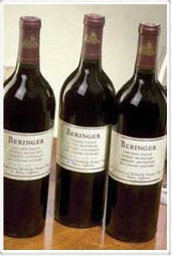
External search
Google (images)
Wine Advocate
Wine Spectator
Burghound
Wine-Searcher
Vintages
2001
2000
1999
1998
1997
1996
1995
1994
From this producer
Show all wines
All tasting notes
|
| Drinking Windows and Values |
| Community Tasting History |
| Community Tasting Notes (average 90.2 pts. and median of 91 pts. in 6 notes) - hiding notes with no text | | | Tasted by Huggs on 1/26/2019: Great for 1994 (673 views) | | | Tasted by WineFish-Queen on 1/22/2017 & rated 90 points: decanted 2 hours before serving. Sherry nose and flavor plus VA evaporated and drank really well.
The wine looks garnet colored. (1153 views) | | | Tasted by Rezy13 on 3/7/2014 & rated 91 points: Friday Night Double Blind $30+ (Bin 75): Dark core, slightly cloudy, thin bricking; hard red currant, some plastic, cabbage, dill, cedar, sweet fruit, anise on the finish, structured; called '94 Napa Cab. (2248 views) | | | Tasted by rjonwine@gmail.com on 4/16/2009 & rated 91 points: Beringer Cabs and Merlots '94-'95 Blindtasted (Tom's House, Palo Alto, CA): Group's #5 (my #2) – 61 pts.; 1, 2, 3, 1 – dark red violet color; nice berry, ripe plum and mulberry nose, that changes to more of a charcoal, tart black fruit and green peppercorn nose; berry, tart black fruit palate with density and depth, that, unfortunately, narrows with time in the glass; medium finish 91+ pts. (2839 views) | | | Tasted by Jay A on 2/1/2009 & rated 88 points: This definitely has some individual character, but I can't help to think that some blending with other vineyards would have rounded out the wine better. The wine starts out a bit short and unexpressive. After some air the fruit becomes more prominent and the tannins start to fan out. This wine, even at 15 years is very lean and young. (2948 views) |
| By Stephen Tanzer
Vinous, May/June 1998, IWC Issue #78
(Beringer Vineyards Cabernet Sauvignon Tre Colline Vineyard) Subscribe to see review text. | By Richard Jennings
RJonWine.com (4/16/2009)
(Beringer Vineyards Cabernet Sauvignon Tre Colline) Group's #5 (my #2) – 61 pts.; 1, 2, 3, 1 – dark red violet color; nice berry, ripe plum and mulberry nose, that changes to more of a charcoal, tart black fruit and green peppercorn nose; berry, tart black fruit palate with density and depth, that, unfortunately, narrows with time in the glass; medium finish 91+ pts. 91 points |
NOTE: Scores and reviews are the property of Vinous and RJonWine.com. (manage subscription channels) |
| Beringer Vineyards Producer websiteCabernet SauvignonCabernet Sauvignon is probably the most famous red wine grape variety on Earth. It is rivaled in this regard only by its Bordeaux stablemate Merlot, and its opposite number in Burgundy, Pinot Noir. From its origins in Bordeaux, Cabernet has successfully spread to almost every winegrowing country in the world. It is now the key grape variety in many first-rate New World wine regions, most notably Napa Valley, Coonawarra and Maipo Valley. Wherever they come from, Cabernet Sauvignon wines always seem to demonstrate a handful of common character traits: deep color, good tannin structure, moderate acidity and aromas of blackcurrant, tomato leaf, dark spices and cedarwood.
Used as frequently in blends as in varietal wines, Cabernet Sauvignon has a large number of common blending partners. Apart from the obvious Merlot and Cabernet Franc, the most prevalent of these are Malbec, Petit Verdot and Carmenere (the ingredients of a classic Bordeaux Blend), Shiraz (in Australia's favorite blend) and in Spain and South America, a Cabernet – Tempranillo blend is now commonplace. Even the bold Tannat-based wines of Madiran are now generally softened with Cabernet SauvignonUSAAmerican wine has been produced since the 1500s, with the first widespread production beginning in New Mexico in 1628. Today, wine production is undertaken in all fifty states, with California producing 84% of all U.S. wine. The continent of North America is home to several native species of grape, including Vitis labrusca, Vitis riparia, Vitis rotundifolia, and Vitis vulpina, but the wine-making industry is based almost entirely on the cultivation of the European Vitis vinifera, which was introduced by European settlers. With more than 1,100,000 acres (4,500 km2) under vine, the United States is the fourth-largest wine producing country in the world, after Italy, Spain, and France.California2021 vintage: "Unlike almost all other areas of the state, the Russian River Valley had higher than normal crops in 2021, which has made for a wine of greater generosity and fruit forwardness than some of its stablemates." - Morgan Twain-Peterson Napa Valley Napa Valley Wineries and Wine (Napa Valley Vintners)Howell Mountain Howell Mountain |
|




